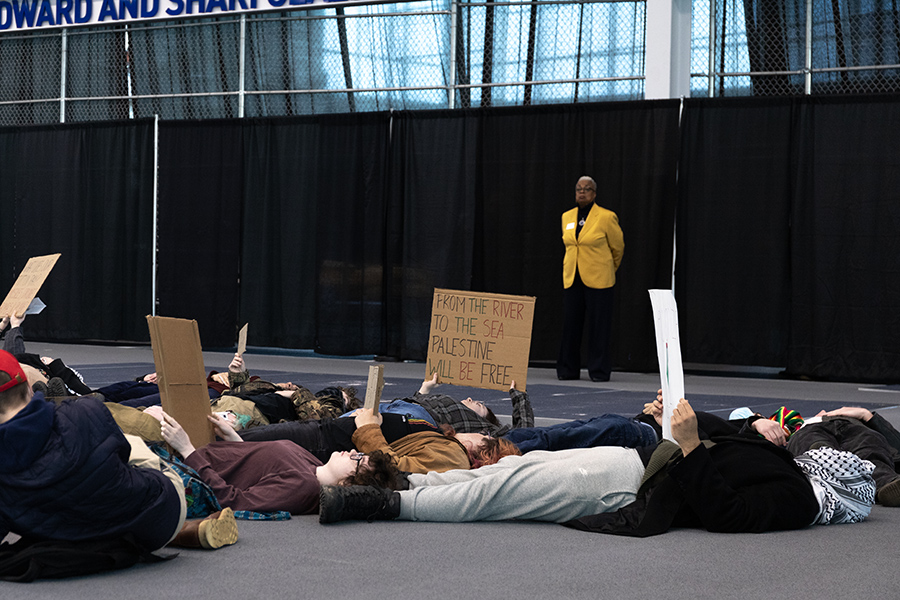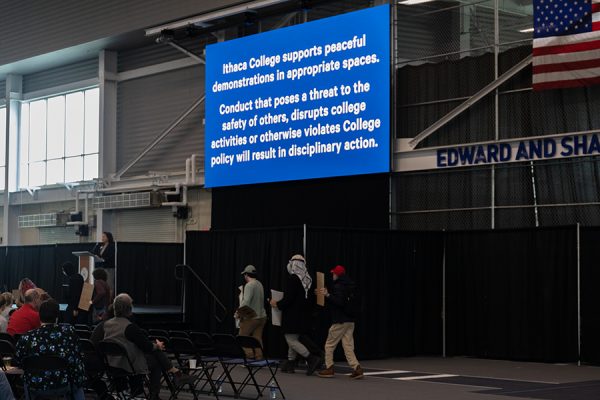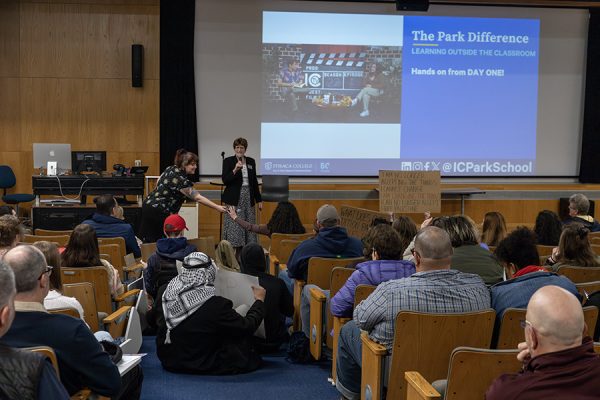
Prakriti Panwar
President La Jerne Cornish stands in the Athletics and Events Center while student demonstrators participated in a die-in during an admissions event for admitted and prospective students at Ithaca College.
This story was last updated at 3:40 p.m. April 21
During the last open house of the semester on April 20, about 15 students from Ithaca College participated in a protest and demonstration organized by Ithaca College Students for Palestine (ICSFP). The protest included chants and die-ins at multiple locations on campus, like the Athletics and Events(A&E) Center, the Roy H. Park School of Communications, the Campus Center and the School of Business.
After chanting at the A&E for 30 minutes, the students walked into the Glazer Arena in the A&E center at around 9:37 a.m. to conduct their first die-in of the day in support of Palestine and to protest President La Jerne Cornish’s rejection of ICSFP’s demands. Approximately 200 prospective and admitted students, their parents and families were present at the Glazer Arena.

The students gathered at the front of the stage, holding signs supporting Palestine while Nicole Eversley Bradwell, executive director of admissions, stood on stage to direct prospective students before they broke off into smaller, school-specific groups for the next leg of their tour.
“I’m going to stop [speaking] for just a moment as students position themselves,” Bradwell said. “These are certainly difficult times locally and in our world and so I appreciate you acknowledging the silence for a moment to all be on the same page that this is a difficult time.”

When Bradwell stopped speaking, about four to five parents approached Cornish to voice concerns about the student protest. Helene Epstein, a parent of an admitted student, said there should have been more of a focus on supporting Jewish students during the protest.
“My son is admitted here,” Epstein said. “We had high hopes to send my child here. I am sick, I’m sick to my stomach. When a president says that these protests are allowed to happen … she should have said, ‘However, we also do protect our Jewish students.’ Those words didn’t come out of her mouth.”
Epstein said she did not want to enroll her son at the college after what she experienced on the day of the protest.
“We’re done — we’re ready to walk out now,” Epstein said. “We drove several hours last night to come here; this was going to seal the deal.”
Cornish said in an interview with The Ithacan after the first die-in that the college believes in free speech and the students had a right to protest peacefully.
“I am the president of all students, all,” Cornish said. “And I will defend their right to free speech, their right to protest, as long as they do so peacefully, and that’s what we’ve witnessed.”

Nola Gooch said she was a 16-year-old prospective student and that she liked that the students were able to voice their opinions maturely.
“I thought it was a really important statement that they were making, coming in front of the crowd and holding up their posters; I just thought it was really interesting to see and bring awareness to that,” Gooch said.
After their demonstration at A&E, the group headed toward the Campus Center to decide where they wished to go next. The college had campus police following the group of demonstrating students throughout the day. No students were arrested or confronted by the police.
Protests on other college campuses, like Columbia University, have resulted in protesters getting arrested by city police. One hundred and eight people protesting on the South Lawn of the university were arrested April 18, according to Axios.
In an interview with The Ithacan after the group’s first die-in at the A&E, Dave Maley, director of public relations, referred to section 2.31.1 of the Student Conduct Code, Freedom of Speech and Peaceful Assembly when asked about potential consequences for students.
“Ithaca College supports the rights of members of our campus community to peacefully protest, as long as it doesn’t create a danger or hazard for others or disrupt the operations of the college or activities,” Maley said. “And what took place today at the A&E Center did not … create a disruption or a danger.”
Maley said students or parents who might be in the middle of the college decision process right now should consider the political climate on campuses and also reflect on the culture of engagement higher education aims to foster.
“I would hope that students and families considering Ithaca College would recognize that this is the kind of issue that is being discussed and debated at every college and university across the country right now,” Maley said. “I think … if people are doing other visits and [are] unhappy about what they saw today, that they think about what it means to get a higher education, get a college education, and that involves learning about differences.”
The protestors then walked to the Park School. They conducted another die-in in the lobby but were told they could not by Bonnie Prunty, vice president of Student Affairs and Campus Life, because of the safety concerns of blocked exit points. Protestors then moved to the Park Auditorium where Amy Falkner, dean of the Park School of Communications, was giving a presentation.


Protestors marched through the School of Business, the Peggy Ryan Williams Center and Campus Center silently holding signs until 11 a.m.. The protestors were followed by Prunty, Thomas Dunn, director and deputy chief of Public Safety and Emergency Management, Patrol Officer Matthew Patire and Patrol Officer Alex Hitchcock.
Quincey Fireside, president of ICSFP, said the protest was the group’s most effective one so far and said the support of the die-in from the student body inspired the organization to engage in more direct action.
“We had prospective students cheering us on, we had parents cheering us on, we had professors cheering us on,” Fireside said. “I think this was big for us.”
After their demonstration from Park to Campus Center, protestors then walked back to the A&E Center around 11 a.m. to continue to chant phrases like, “Free, Free Palestine,” “Cornish, Cornish you can’t hide, you’re supporting genocide” and “Isreael bombs, Ithaca pays, how many kids did you kill today?”
The group of students, which had shrunk to about seven people, paused after continuously chanting for about 30 minutes on a hill outside of the A&E center. About 10 minutes later, the group entered the building as admitted students and their families had lunch.
Niccolo Missa, a 17-year-old high school student, said the demonstration did not change his mind about attending the college in the fall.
“I don’t really mind [the demonstration], as long as it’s peaceful,” Missa said. “My choice in the school is about the programs. But this is not going to affect my choice at all.”
For the last leg of their demonstration, the group entered the building and silently walked through the rows of tables while holding signs. After about 10 minutes, the group sat down in the center of the lunch tables with their signs.
As the students sat quietly in the center of the room, Terri Kelly, the father of an admitted student, said he talked to the students who were demonstrating. Kelly said that after speaking with the students, he was content to know the college supported free speech.
“I’m actually happy that [the college is] allowing the protest,” Kelly said. “And they’re not stamping that sort of stuff out.”
Kelly’s daughter, Grayson Kelly, said she also felt more comfortable about attending the college in the fall after seeing the demonstration.
“It definitely makes me see that there’s a lot of like activism on campus,” Kelly said. “I mean, that’s good to see that the campus supports freedom of speech.”
The students sat in the A&E Center for about 30 minutes. After the sit-in, the students got up and walked around the area where people sat having lunch and then left the building, ending the demonstration for the day around 1 p.m.
Senior Shannon Connor said she has been a Resident Assistant for three years and said she could hear protestors from her room in Lyon Hall.
“I was on FaceTime with my dad and …. my dad [was straight up] like ‘if we had come to Ithaca as an accepting student when I came years ago,’ he would definitely not let me come to it to go because of this,” Connor said.
Connor said it would have made more sense for the organization to take a more passive approach, instead of organizing a noise demonstration.
“Even though whatever they’re posting is protesting is important … it’s going to be missed,” Connor said. “Like any message that you have [is] going to totally go over anybody’s head.”
Connor said some of her residents were concerned about their safety when they heard the protestors.
“I have residents who are Jewish … they go on the Birthright trips to Israel and they feel extremely unsafe,” Connor said. “They were like ‘[protestors] can’t get into the buildings can they?’ and I was like ‘Absolutely not.’”
Connor said the protesting students should also have thought more about the impact they were trying to make and whose attention they were trying to get.
“[Prospective or admitted students and their families] have no stake in the game,” Connor said. “This wasn’t somebody who can make a difference. This wasn’t somebody who is in a higher-up position. … These were innocent people who were just walking by on a nice Saturday with their kids.”
Podcast Editor Emma Kersting contributed reporting.